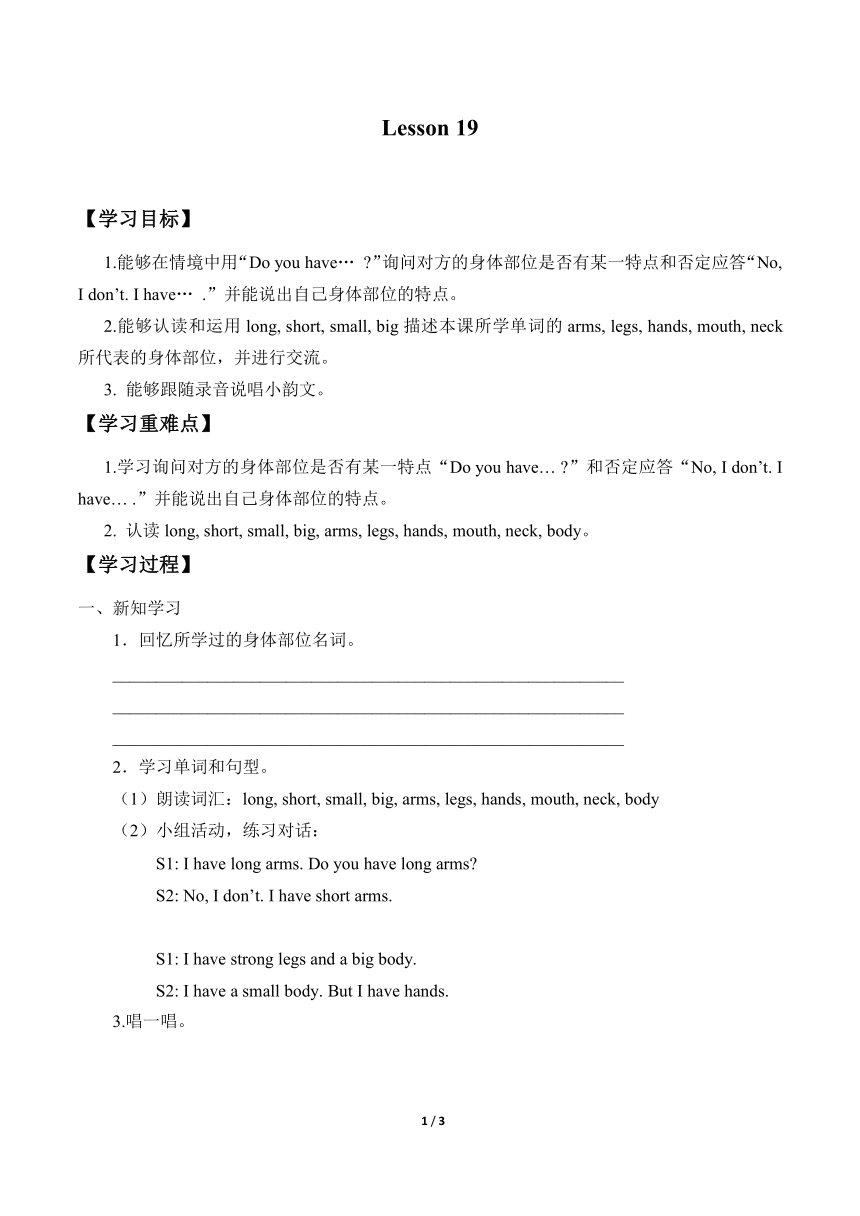Unit 5 I have long arms Lesson 19 学案(无答案)
文档属性
| 名称 | Unit 5 I have long arms Lesson 19 学案(无答案) |

|
|
| 格式 | zip | ||
| 文件大小 | 517.0KB | ||
| 资源类型 | 教案 | ||
| 版本资源 | 北京版 | ||
| 科目 | 英语 | ||
| 更新时间 | 2019-11-28 17:19:54 | ||
图片预览

文档简介
Lesson 19
【学习目标】
1.能够在情境中用“Do you have… ?”询问对方的身体部位是否有某一特点和否定应答“No, I don’t. I have… .”并能说出自己身体部位的特点。
2.能够认读和运用long, short, small, big描述本课所学单词的arms, legs, hands, mouth, neck所代表的身体部位,并进行交流。
3. 能够跟随录音说唱小韵文。
【学习重难点】
1.学习询问对方的身体部位是否有某一特点“Do you have… ?”和否定应答“No, I don’t. I have… .”并能说出自己身体部位的特点。
2. 认读long, short, small, big, arms, legs, hands, mouth, neck, body。
【学习过程】
一、新知学习
1.回忆所学过的身体部位名词。
___________________________________________________________
___________________________________________________________
___________________________________________________________
2.学习单词和句型。
(1)朗读词汇:long, short, small, big, arms, legs, hands, mouth, neck, body
(2)小组活动,练习对话:
S1: I have long arms. Do you have long arms?
S2: No, I don’t. I have short arms.
S1: I have strong legs and a big body.
S2: I have a small body. But I have hands.
3.唱一唱。
二、达标检测
1. 看中文,选英文。
( ) 手 A. hand B. arm
( ) 身体 A. body B. boy
( ) 毛发 A. eye B. hair
( ) 腿 A. arm B. leg
2. 你能根据描述猜出是什么动物吗?
( ) It is big. It has a long nose and a big body. What is it?
( ) It is small. It has hands and long arms. What is it?
( ) It has a big tail and short arms. What is it?
( ) It has a long neck and long legs. What is it?
A. B.
C. D.
【学习目标】
1.能够在情境中用“Do you have… ?”询问对方的身体部位是否有某一特点和否定应答“No, I don’t. I have… .”并能说出自己身体部位的特点。
2.能够认读和运用long, short, small, big描述本课所学单词的arms, legs, hands, mouth, neck所代表的身体部位,并进行交流。
3. 能够跟随录音说唱小韵文。
【学习重难点】
1.学习询问对方的身体部位是否有某一特点“Do you have… ?”和否定应答“No, I don’t. I have… .”并能说出自己身体部位的特点。
2. 认读long, short, small, big, arms, legs, hands, mouth, neck, body。
【学习过程】
一、新知学习
1.回忆所学过的身体部位名词。
___________________________________________________________
___________________________________________________________
___________________________________________________________
2.学习单词和句型。
(1)朗读词汇:long, short, small, big, arms, legs, hands, mouth, neck, body
(2)小组活动,练习对话:
S1: I have long arms. Do you have long arms?
S2: No, I don’t. I have short arms.
S1: I have strong legs and a big body.
S2: I have a small body. But I have hands.
3.唱一唱。
二、达标检测
1. 看中文,选英文。
( ) 手 A. hand B. arm
( ) 身体 A. body B. boy
( ) 毛发 A. eye B. hair
( ) 腿 A. arm B. leg
2. 你能根据描述猜出是什么动物吗?
( ) It is big. It has a long nose and a big body. What is it?
( ) It is small. It has hands and long arms. What is it?
( ) It has a big tail and short arms. What is it?
( ) It has a long neck and long legs. What is it?
A. B.
C. D.
同课章节目录
- Unit 1 What day is today?
- Lesson 1
- Lesson 2
- Lesson 3
- Lesson 4
- Unit 2 What do you do on Sunday?
- Lesson 5
- Lesson 6
- Lesson 7
- Lesson 8
- Unit 3 What's your number?
- Lesson 9
- Lesson 10
- Lesson 11
- Lesson 12
- Unit 4 There are many animals
- Lesson 13
- Lesson 14
- Lesson 15
- Lesson 16
- Unit 5 I have long arms
- Lesson 17
- Lesson 18
- Lesson 19
- Lesson 20
- Unit 6 It‘s Christmas Day
- Lesson 21
- Lesson 22
- Lesson 23
- Lesson 24
